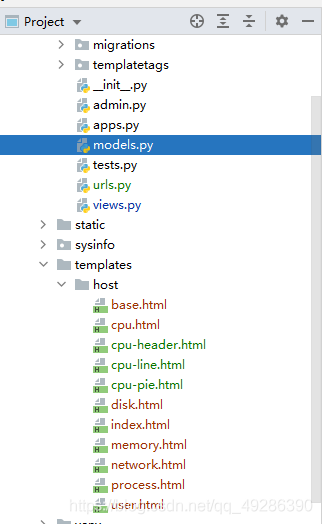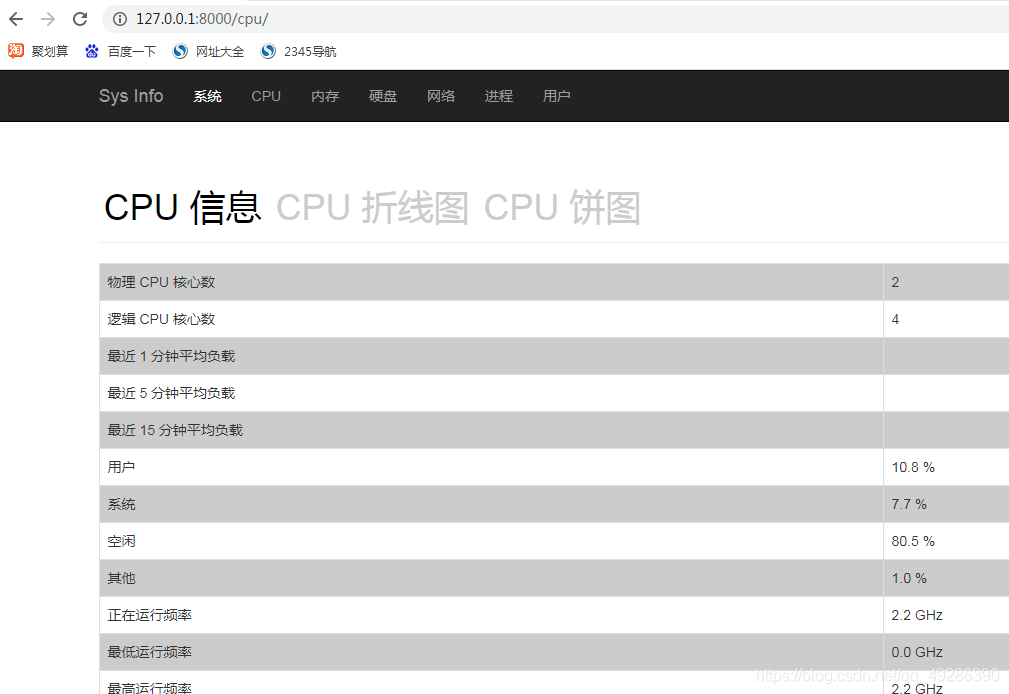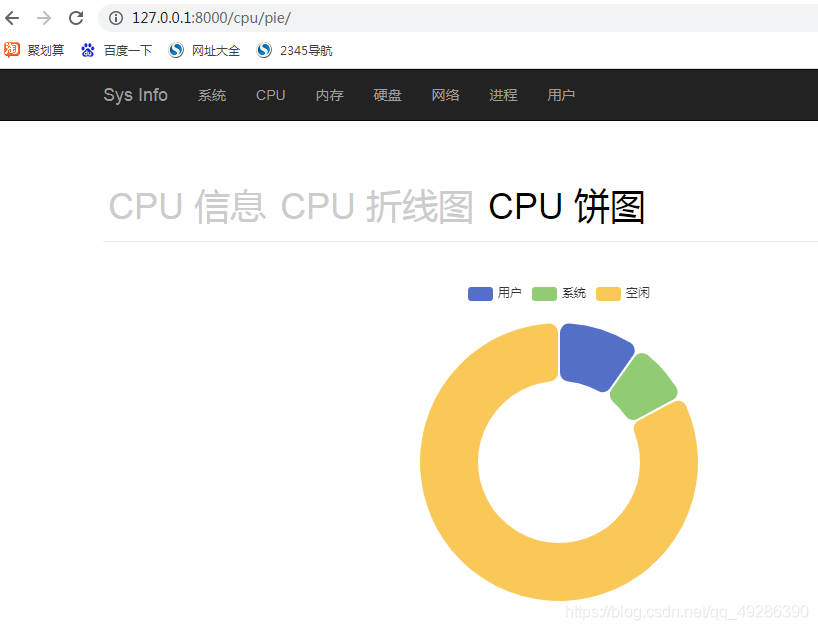一、后台管理基础配置
1.>python manage.py startapp host
2.设置本地化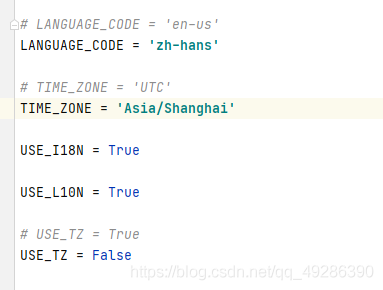
3.创建数据库表和超级用户
python manage.py makemigrations
python manage.py migrate
python manage.py createsuperuser
4.git管理项目
1)生成.gitignore(可忽略的文件不会被上传)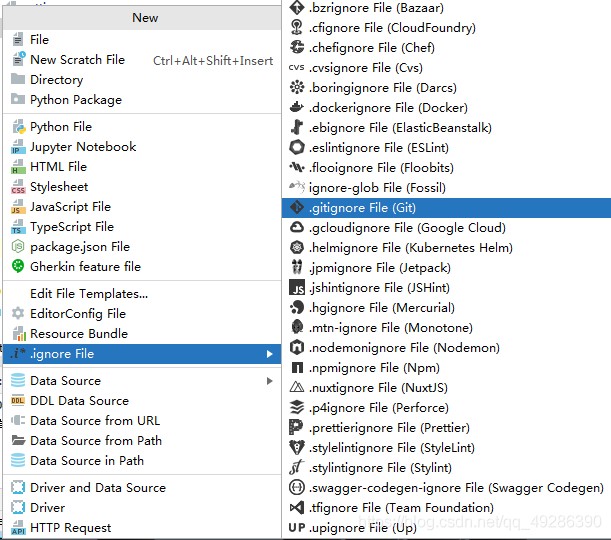
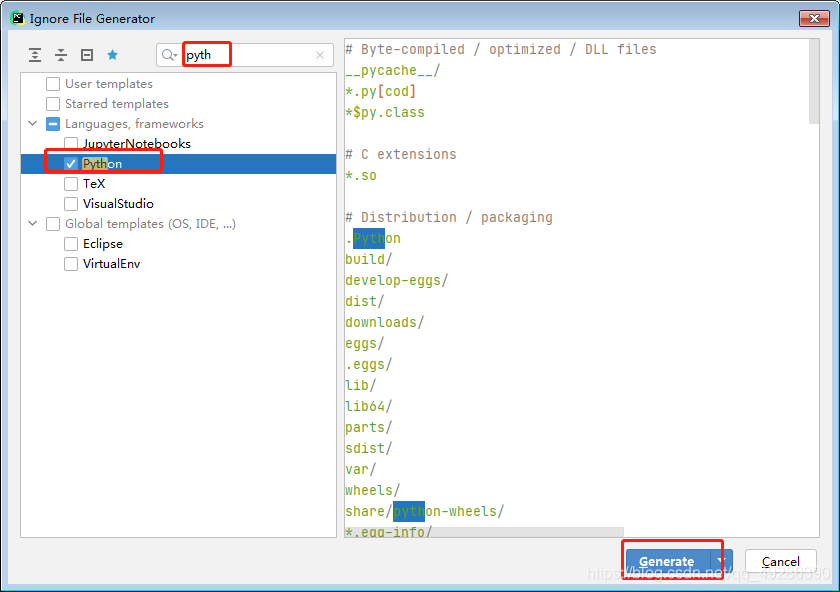
2).生成requrements.txt和README.md文件
pip freeze > requrements.txt
(pip freeze:查看自己安装的软件包)
3).添加保存设置
git init
git add *
git commit -m "add requirements.txt and README.md"

5. 文件编辑
# sysinfo/urls.py
from django.contrib import admin
from django.urls import path, include
urlpatterns = [
path('admin/', admin.site.urls),
path('', include('host.urls'))
]
#host/urls.py
from django.contrib import admin
from django.urls import path, include
from .views import *
urlpatterns = [
path('', index, name='index'),
path('user/', user, name='user'),
path('cpu/', cpu, name='cpu'),
path('memory/', memory, name='memory'),
path('disk/', disk, name='disk'),
path('network/', network, name='network'),
path('process/', process, name='process'),
]
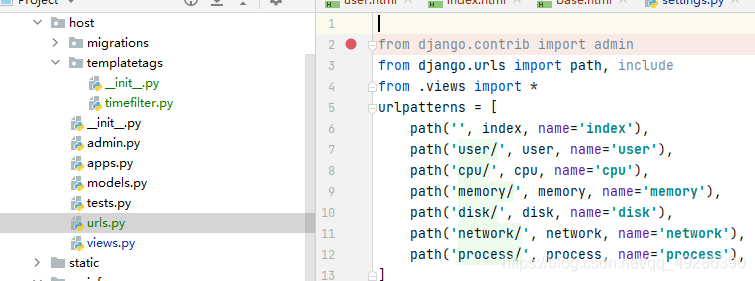
#host/views.py
from django.shortcuts import render
# Create your views here.
def index(request):
pass
return render(request, 'host/index.html', locals())
def user(request):
pass
return render(request, 'host/user.html', locals())
def cpu(request):
pass
return render(request, 'host/cpu.html', locals())
def memory(request):
pass
return render(request, 'host/memory.html', locals())
def disk(request):
pass
return render(request, 'host/disk.html', locals())
def network(request):
pass
return render(request, 'host/network.html', locals())
def process(request):
pass
return render(request, 'host/process.html', locals())
6.在模块下建立相应的html文件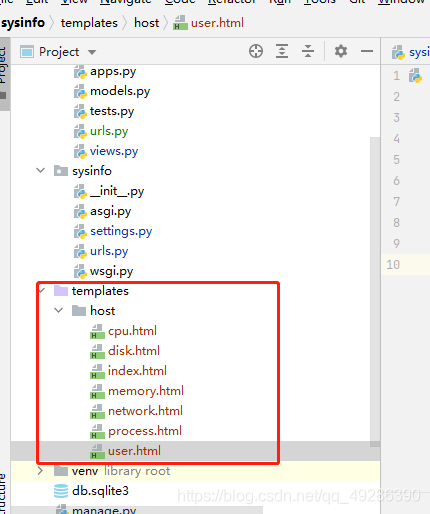
访问测试: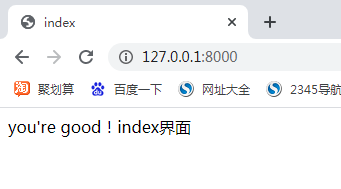
二、前端管理 首页展示(显示系统信息)
#settings.py
STATICFILES_DIRS = [
BASE_DIR / "static",
]

#host/views.py
from datetime import datetime
from django.shortcuts import render
import psutil
import os, platform
# Create your views here.
def index(request):
"""
sys_name
kernel_name
kernel_no
kernel_version
sys_framework
now_time
boot_time
up_time
"""
try:
info = os.uname()
except Exception as e:
info = platform.uname()
sys_name = info.node
kernel_name = info.system
kernel_no = info.release
kernel_version = info.version
sys_framework = info.machine
boot_time = datetime.fromtimestamp(psutil.boot_time())
now_time = datetime.now()
print(boot_time, now_time)
up_time = now_time - boot_time
return render(request, 'host/index.html', locals())
def user(request):
pass
return render(request, 'host/user.html', locals())
def cpu(request):
pass
return render(request, 'host/cpu.html', locals())
def memory(request):
pass
return render(request, 'host/memory.html', locals())
def disk(request):
pass
return render(request, 'host/disk.html', locals())
def network(request):
pass
return render(request, 'host/network.html', locals())
def process(request):
pass
return render(request, 'host/process.html', locals())
并导入此目录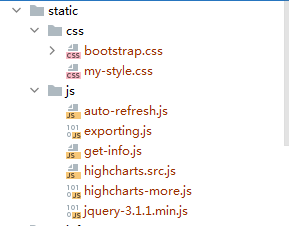
#base.html
<!DOCTYPE html>
<html {% block html_attribs %}{% endblock html_attribs %}>
<head>
{% block head %}
<meta http-equiv="Content-Type" content="text/html; charset=utf-8">
<meta name="viewport" content="width=device-width, initial-scale=1">
<title>{% block title %} {% endblock title %}</title>
<link rel="stylesheet" type="text/css" href="/static/css/bootstrap.css">
<link rel="stylesheet" type="text/css" href="/static/css/my-style.css">
<script src="/static/js/jquery-3.1.1.min.js"></script>
{% endblock head %}
</head>
<body>
<div class="sysinfo">
<div class="navbar navbar-inverse" role="navigation">
<div class="container">
<div class="navbar-header">
<a class="navbar-brand" href="/">Sys Info</a>
</div>
<div class="navbar-collapse collapse">
<ul class="nav navbar-nav">
<li><a href="/">系统</a></li>
<li><a href="/cpu/">CPU</a></li>
<li><a href="/memory/">内存</a></li>
<li><a href="/disk/">硬盘</a></li>
<li><a href="/network/">网络</a></li>
<li><a href="/process/">进程</a></li>
<li><a href="/user/">用户</a></li>
</ul>
</div>
</div>
</div>
<div class="container">
{% block content %}{% endblock %}
</div>
</div>
</body>
</html>
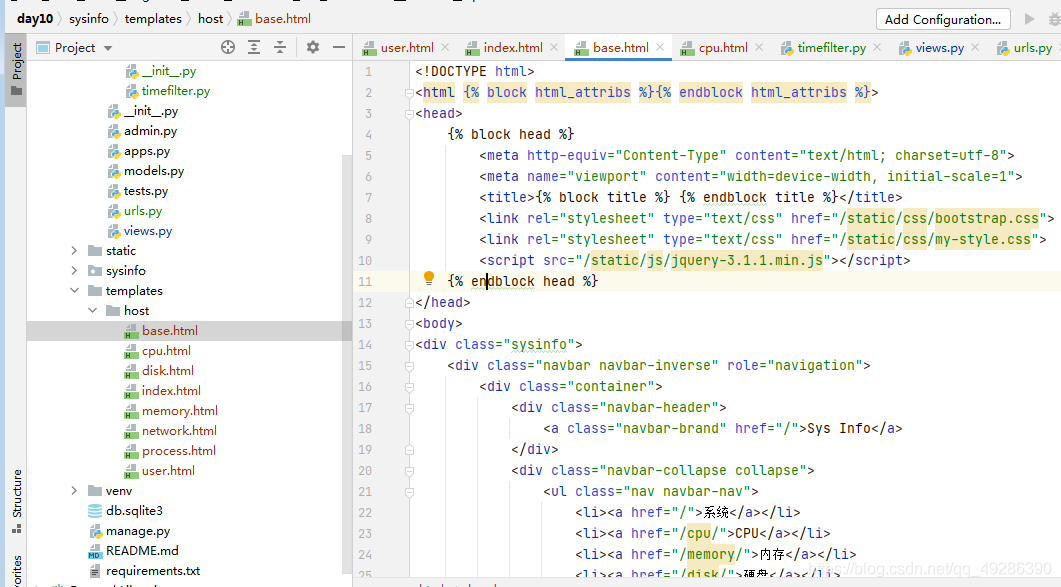
#index.html
{% extends 'host/base.html' %}
{% block title %}Sys Info{% endblock %}
{% block content %}
<div class="page-header">
<h1>系统信息</h1>
</div>
<div>
<table class="table table-bordered">
<tr>
<td>主机名</td>
<td>{{ sys_name }}</td>
</tr>
<tr>
<td>内核名称</td>
<td>{{ kernel_name }}</td>
</tr>
<tr>
<td>发行版本号</td>
<td>{{ kernel_no }}</td>
</tr>
<tr>
<td>内核版本</td>
<td>{{ kernel_version }}</td>
</tr>
<tr>
<td>系统架构</td>
<td>{{ sys_framework }}</td>
</tr>
<tr>
<td>现在时间</td>
<td>{{ now_time }}</td>
</tr>
<tr>
<td>开机时间</td>
<td>{{ boot_time }}</td>
</tr>
<tr>
<td>运行时间</td>
<td>{{ up_time }}</td>
</tr>
</table>
</div>
{% endblock %}
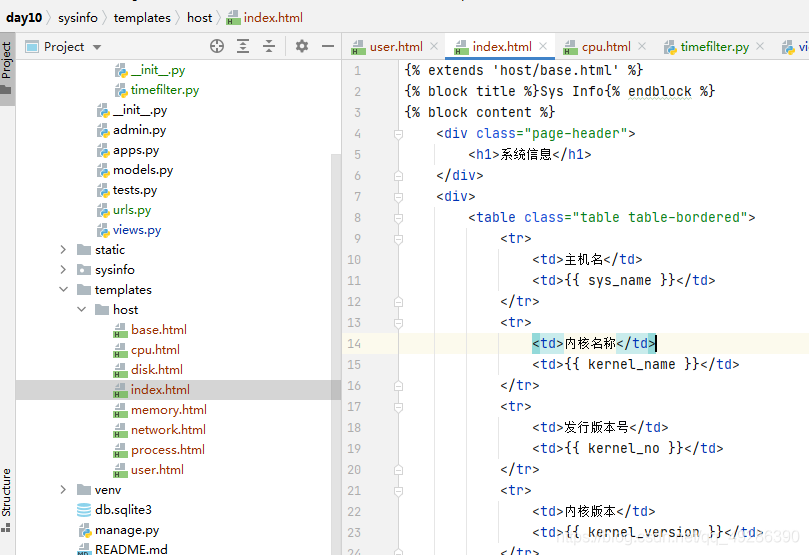
访问测试: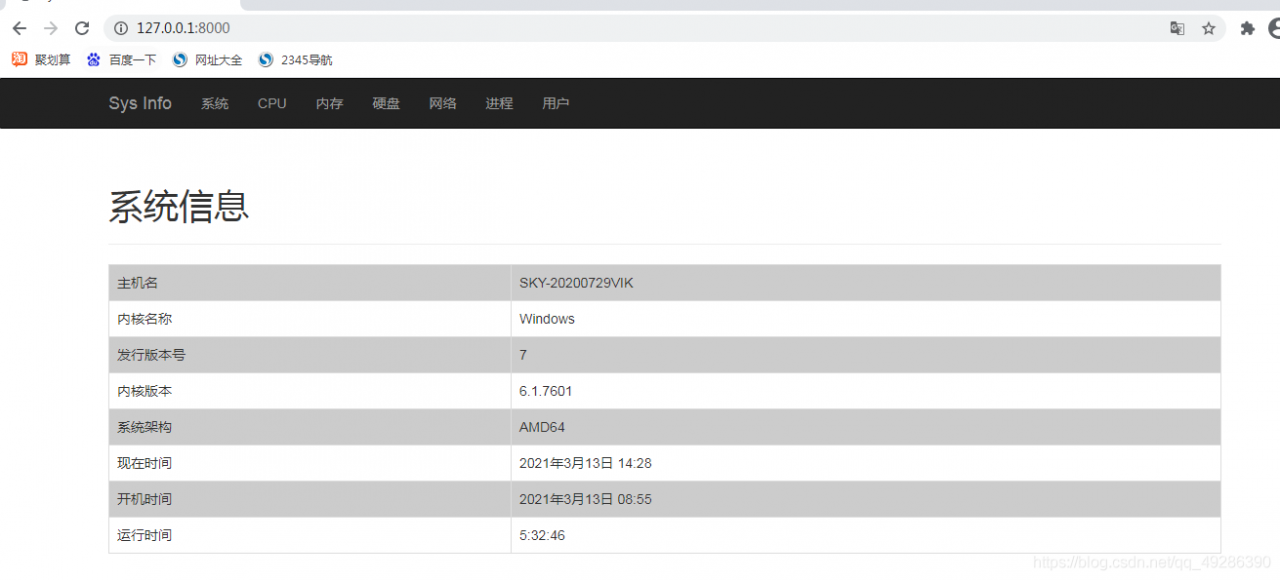
三、用户页面的前后端设置(自定义过滤器)
#host/views.py
def user(request):
users = psutil.users()
return render(request, 'host/user.html', locals())
#user.html
{% extends 'host/base.html' %}
{% load timefilter %}
{% block title %} 用户信息 {% endblock %}
{% block content %}
<div class="page-header">
<h1>登录用户</h1>
</div>
<div>
<table class="table table-bordered">
<tr>
<td>用户名</td>
<td>登录主机</td>
<td>终端</td>
<td>登录时间</td>
</tr>
{% for user in users %}
<tr>
<td>{{ user.name }}</td>
<td>{{ user.terminal }}</td>
<td>{{ user.host }}</td>
<td>{{ user.started | timefmt }}</td>
</tr>
{% endfor %}
</table>
</div>
{% endblock %}
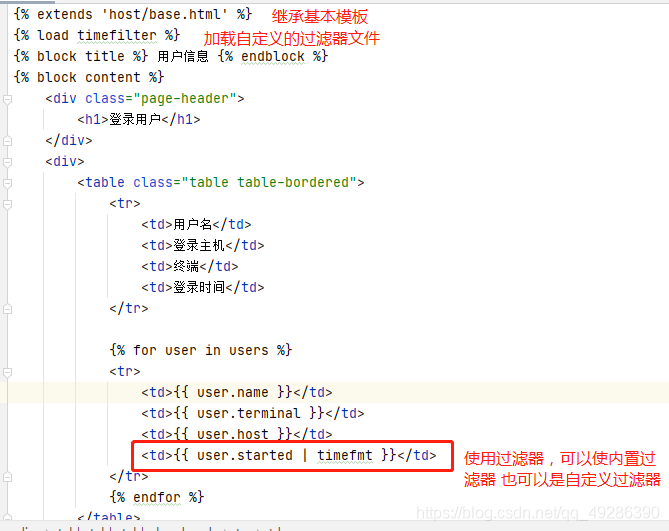
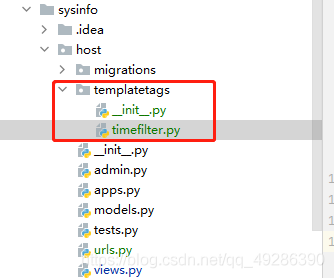
#timefilter.py
"""
自定义过滤器实现的方法:
https://docs.djangoproject.com/zh-hans/3.1/howto/custom-template-tags/
"""
from django import template
from datetime import datetime
register = template.Library()
@register.filter(name='timefmt')
def timefmt(value):
"""将时间戳转换成datetime类型的时间"""
return datetime.fromtimestamp(value)
访问测试:(重新启动下在运行)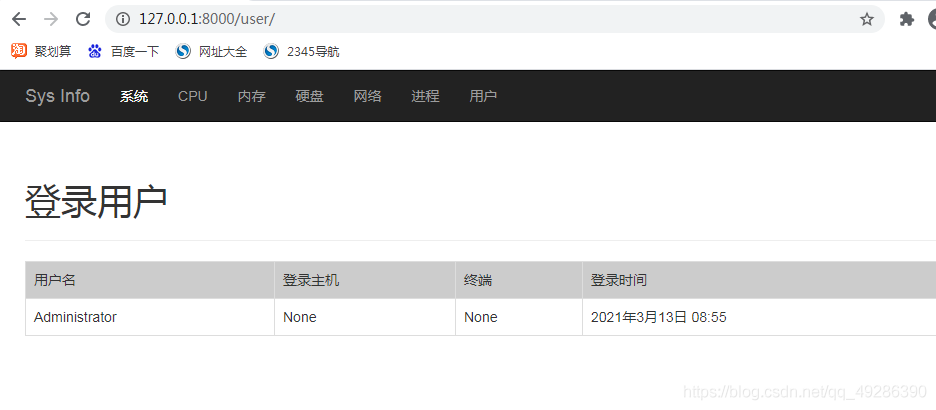
四、CPU页面的前后端设置(基于echarts的图形展示)
#host/views.py
from datetime import datetime
from django.shortcuts import render
import psutil
import os, platform
# Create your views here.
def index(request):
"""
sys_name
kernel_name
kernel_no
kernel_version
sys_framework
now_time
boot_time
up_time
"""
try:
info = os.uname()
except Exception as e:
info = platform.uname()
sys_name = info.node
kernel_name = info.system
kernel_no = info.release
kernel_version = info.version
sys_framework = info.machine
boot_time = datetime.fromtimestamp(psutil.boot_time())
now_time = datetime.now()
print(boot_time, now_time)
up_time = now_time - boot_time
return render(request, 'host/index.html', locals())
def user(request):
users = psutil.users()
return render(request, 'host/user.html', locals())
def cpu(request):
logical_core_num = psutil.cpu_count() #
physical_core_num = psutil.cpu_count(logical=False)
try:
load_avg = os.getloadavg()
except Exception as e:
load_avg = ['', '', '']
cpu_time_percent = psutil.cpu_times_percent()
else_percent = 0.0
for i in range(5):
else_percent += cpu_time_percent[i]
try:
cpu_freq = psutil.cpu_freq()
except AttributeError:
cpu_freq = None
return render(request, 'host/cpu.html', locals())
def memory(request):
pass
return render(request, 'host/memory.html', locals())
def disk(request):
pass
return render(request, 'host/disk.html', locals())
def network(request):
pass
return render(request, 'host/network.html', locals())
def process(request):
pass
return render(request, 'host/process.html', locals())
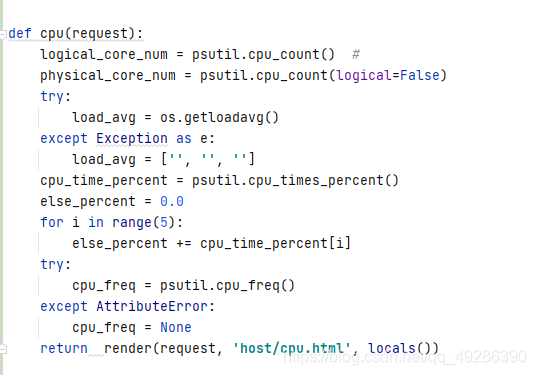
#host/templatetags/timefilter.py
@register.filter(name='cpu_val_fmt')
def cpu_val_fmt(value):
return round(value/1000, 2)
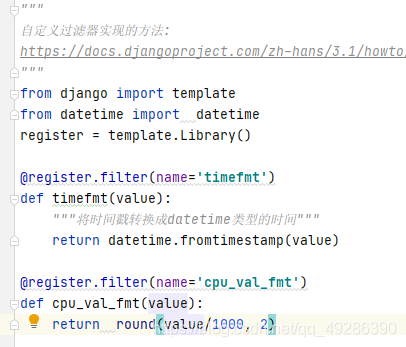
#cpu.html
{% extends 'host/base.html' %}
{% load timefilter %}
{% block title %} cpu信息 {% endblock %}
{% block content %}
<div class="page-header">
<a {% if not chart %}id="display"{% endif %} href="/cpu/">CPU 信息</a>
<a {% if chart == 'line' %}id="display"{% endif %} href="/cpu/">CPU
折线图</a>
<a {% if chart == 'pie' %}id="display"{% endif %} href="/cpu/">CPU 饼图</a>
</div>
<div>
<div id="cpu_info">
<table class="table table-bordered">
<tr>
<td>物理 CPU 核心数</td>
<td>{{ physical_core_num }}</td>
</tr>
<tr>
<td>逻辑 CPU 核心数</td>
<td>{{ logical_core_num }}</td>
</tr>
<tr>
<td>最近 1 分钟平均负载</td>
<td>{{ load_avg.0 }}</td>
</tr>
<tr>
<td>最近 5 分钟平均负载</td>
<td>{{ load_avg.1 }}</td>
</tr>
<tr>
<td>最近 15 分钟平均负载</td>
<td>{{ load_avg.2 }}</td>
</tr>
<tr>
<td>用户</td>
<td>{{ cpu_time_percent.user }} %</td>
</tr>
<tr>
<td>系统</td>
<td>{{ cpu_time_percent.system }} %</td>
</tr>
<tr>
<td>空闲</td>
<td>{{ cpu_time_percent.idle }} %</td>
</tr>
{% if cpu_time_percent.nice %}
<tr>
<td>nice</td>
<td>{{ cpu_time_percent.nice }} %</td>
</tr>
{% endif %}
{% if cpu_time_percent.iowait %}
<tr>
<td>iowait</td>
<td>{{ cpu_time_percent.iowait }} %</td>
</tr>
{% endif %}
{% if else_percent %}
<tr>
<td>其他</td>
<td>{{ else_percent }} %</td>
</tr>
{% endif %}
{% if cpu_freq %}
<tr>
<td>正在运行频率</td>
<td>{{ cpu_freq.current | cpu_val_fmt }} GHz</td>
</tr>
<tr>
<td>最低运行频率</td>
<td>{{ cpu_freq.min | cpu_val_fmt }} GHz</td>
</tr>
<tr>
<td>最高运行频率</td>
<td>{{ cpu_freq.max | cpu_val_fmt }} GHz</td>
</tr>
{% endif %}
</table>
</div>
{% endblock %}
访问测试: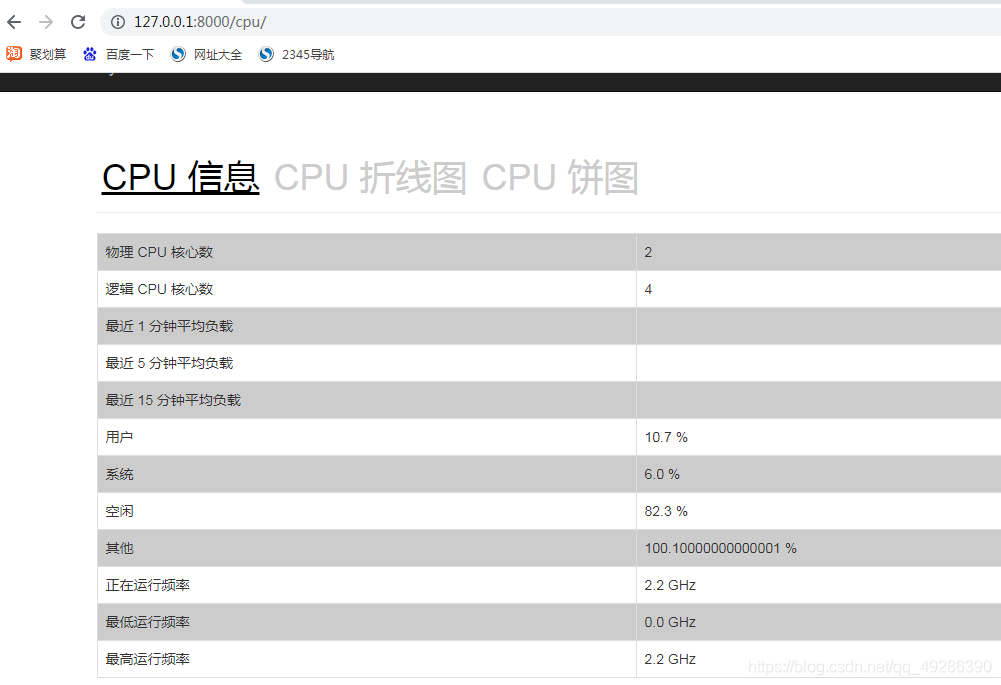
2.基于echarts的扇形图展示(以及一些细节操作)
#host/models.py
from django.db import models
# Create your models here.
# 定时任务定期扫描并存储。
class UserCpuPercent(models.Model):
create_time = models.DateTimeField(auto_now_add=True, verbose_name="扫描时间")
user_percent = models.FloatField(verbose_name="用户CPU占用百分比")
#host/urls
from django.contrib import admin
from django.urls import path, include
from .views import *
urlpatterns = [
path('', index, name='index'),
path('user/', user, name='user'),
path('cpu/', cpu, name='cpu'),
path('cpu/<str:chart>/', cpu, name='cpu'),
path('memory/', memory, name='memory'),
path('disk/', disk, name='disk'),
path('network/', network, name='network'),
path('process/', process, name='process'),
]
#host/views.py
from datetime import datetime
from django.shortcuts import render
import psutil
import os, platform
# Create your views here.
def index(request):
try:
info = os.uname()
except Exception as e:
info = platform.uname()
sys_name = info.node
kernel_name = info.system
kernel_no = info.release
kernel_version = info.version
sys_framework = info.machine
boot_time = datetime.fromtimestamp(psutil.boot_time())
now_time = datetime.now()
print(boot_time, now_time)
up_time = now_time - boot_time
return render(request, 'host/index.html', locals())
def user(request):
users = psutil.users()
return render(request, 'host/user.html', locals())
def cpu(request, chart=None):
logical_core_num = psutil.cpu_count() #
physical_core_num = psutil.cpu_count(logical=False)
try:
load_avg = os.getloadavg()
except Exception as e:
load_avg = ['', '', '']
cpu_time_percent = psutil.cpu_times_percent()
else_percent = 0.0
for i in range(3, 5):
else_percent += cpu_time_percent[i]
try:
cpu_freq = psutil.cpu_freq()
except AttributeError:
cpu_freq = None
if chart == 'line':
return render(request, 'host/cpu-line.html', locals())
elif chart == 'pie':
return render(request, 'host/cpu-pie.html', locals())
return render(request, 'host/cpu.html', locals())
def memory(request):
pass
return render(request, 'host/memory.html', locals())
def disk(request):
pass
return render(request, 'host/disk.html', locals())
def network(request):
pass
return render(request, 'host/network.html', locals())
def process(request):
pass
return render(request, 'host/process.html', locals())
#base.html
<!DOCTYPE html>
<html {% block html_attribs %}{% endblock html_attribs %}>
<head>
{% block head %}
<meta http-equiv="Content-Type" content="text/html; charset=utf-8">
<meta name="viewport" content="width=device-width, initial-scale=1">
<title>{% block title %} {% endblock title %}</title>
<link rel="stylesheet" type="text/css" href="/static/css/bootstrap.css">
<link rel="stylesheet" type="text/css" href="/static/css/my-style.css">
<script src="/static/js/jquery-3.1.1.min.js"></script>
<script src="https://lib.baomitu.com/echarts/5.0.2/echarts.min.js"></script>
{% endblock head %}
</head>
<body>
<div class="sysinfo">
<div class="navbar navbar-inverse" role="navigation">
<div class="container">
<div class="navbar-header">
<a class="navbar-brand" href="/">Sys Info</a>
</div>
<div class="navbar-collapse collapse">
<ul class="nav navbar-nav">
<li><a href="/">系统</a></li>
<li><a href="/cpu/">CPU</a></li>
<li><a href="/memory/">内存</a></li>
<li><a href="/disk/">硬盘</a></li>
<li><a href="/network/">网络</a></li>
<li><a href="/process/">进程</a></li>
<li><a href="/user/">用户</a></li>
</ul>
</div>
</div>
</div>
<div class="container">
{% block content %}{% endblock %}
</div>
</div>
</body>
</html>
#cpu.html
{% extends 'host/base.html' %}
{% load timefilter %}
{% block title %} cpu信息 {% endblock %}
{% block content %}
{% include 'host/cpu-header.html' %}
<div>
<div id="cpu_info">
<table class="table table-bordered">
<tr>
<td>物理 CPU 核心数</td>
<td>{{ physical_core_num }}</td>
</tr>
<tr>
<td>逻辑 CPU 核心数</td>
<td>{{ logical_core_num }}</td>
</tr>
<tr>
<td>最近 1 分钟平均负载</td>
<td>{{ load_avg.0 }}</td>
</tr>
<tr>
<td>最近 5 分钟平均负载</td>
<td>{{ load_avg.1 }}</td>
</tr>
<tr>
<td>最近 15 分钟平均负载</td>
<td>{{ load_avg.2 }}</td>
</tr>
<tr>
<td>用户</td>
<td>{{ cpu_time_percent.user }} %</td>
</tr>
<tr>
<td>系统</td>
<td>{{ cpu_time_percent.system }} %</td>
</tr>
<tr>
<td>空闲</td>
<td>{{ cpu_time_percent.idle }} %</td>
</tr>
{% if cpu_time_percent.nice %}
<tr>
<td>nice</td>
<td>{{ cpu_time_percent.nice }} %</td>
</tr>
{% endif %}
{% if cpu_time_percent.iowait %}
<tr>
<td>iowait</td>
<td>{{ cpu_time_percent.iowait }} %</td>
</tr>
{% endif %}
{% if else_percent %}
<tr>
<td>其他</td>
<td>{{ else_percent }} %</td>
</tr>
{% endif %}
{% if cpu_freq %}
<tr>
<td>正在运行频率</td>
<td>{{ cpu_freq.current | cpu_val_fmt }} GHz</td>
</tr>
<tr>
<td>最低运行频率</td>
<td>{{ cpu_freq.min | cpu_val_fmt }} GHz</td>
</tr>
<tr>
<td>最高运行频率</td>
<td>{{ cpu_freq.max | cpu_val_fmt }} GHz</td>
</tr>
{% endif %}
</table>
</div>
</div>
{% endblock %}
#cpu-header.html
<div class="page-header">
<a {% if not chart %}id="display"{% endif %} href="/cpu/">CPU 信息</a>
<a {% if chart == 'line' %}id="display"{% endif %} href="/cpu/line/">CPU
折线图</a>
<a {% if chart == 'pie' %}id="display"{% endif %} href="/cpu/pie/">CPU 饼图</a>
</div>
#cpu-line.html
{% extends 'host/base.html' %}
{% load timefilter %}
{% block title %} cpu信息 {% endblock %}
{% block content %}
{% include 'host/cpu-header.html' %}
<div>
<div id="main" style="width: 80%;height:400px;"></div>
</div>
<script type="text/javascript">
// 基于准备好的dom,初始化echarts实例
var myChart = echarts.init(document.getElementById('main'));
option = {
xAxis: {
type: 'category',
data: ['Mon', 'Tue', 'Wed', 'Thu', 'Fri', 'Sat', 'Sun']
},
yAxis: {
type: 'value'
},
series: [{
data: [820, 932, 901, 934, 1290, 1330, 1320],
type: 'line',
smooth: true
}]
};
// 使用刚指定的配置项和数据显示图表。
myChart.setOption(option);
</script>
{% endblock %}
#cpu-pie.html
{% extends 'host/base.html' %}
{% load timefilter %}
{% block title %} cpu信息 {% endblock %}
{% block content %}
{% include 'host/cpu-header.html' %}
<div>
<div id="main" style="width: 80%;height:400px;"></div>
</div>
<script type="text/javascript">
// 基于准备好的dom,初始化echarts实例
var myChart = echarts.init(document.getElementById('main'));
option = {
tooltip: {
trigger: 'item'
},
legend: {
top: '5%',
left: 'center'
},
series: [
{
name: 'CPU占用百分比分类',
type: 'pie',
radius: ['40%', '70%'],
avoidLabelOverlap: false,
itemStyle: {
borderRadius: 10,
borderColor: '#fff',
borderWidth: 2
},
label: {
show: false,
position: 'center'
},
emphasis: {
label: {
show: true,
fontSize: '40',
fontWeight: 'bold'
}
},
labelLine: {
show: false
},
data: [
{value: {{ cpu_time_percent.user }}, name: '用户'},
{value: {{ cpu_time_percent.system }}, name: '系统'},
{value: {{ cpu_time_percent.idle }}, name: '空闲'},
]
}
]
};
// 使用刚指定的配置项和数据显示图表。
myChart.setOption(option);
</script>
{% endblock %}
生成数据库迁移脚本并导入到数据库
访问测试:
- get
版权声明:本文为qq_49286390原创文章,遵循CC 4.0 BY-SA版权协议,转载请附上原文出处链接和本声明。
